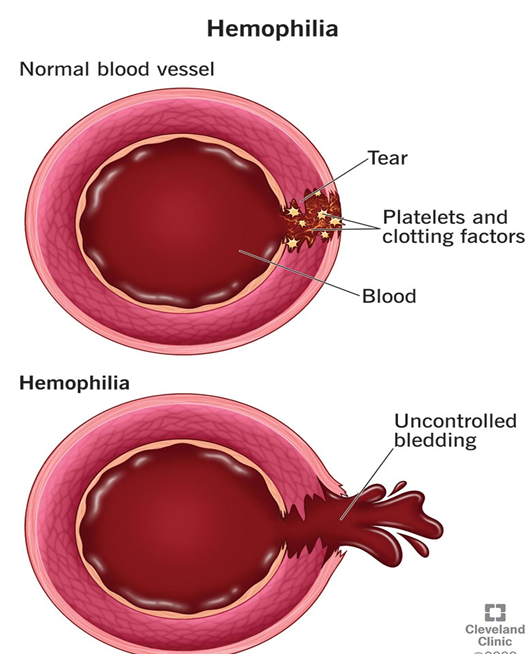Parents of a school-age child with hemophilia ask the nurse, “What sport is recommended for children with hemophilia?” Which sport should the nurse recommend?
Basketball
Swimming
Soccer
Skating
The Correct Answer is B
Choice A reason:
Basketball, while a popular sport, involves a significant amount of physical contact and the risk of falls and injuries1. For children with hemophilia, engaging in contact sports can increase the risk of bleeding episodes and joint damage. Therefore, basketball is not the most recommended sport for children with hemophilia.
Choice B reason:
Swimming is highly recommended for children with hemophilia because it is a low-impact sport that provides excellent cardiovascular exercise without putting undue stress on the joints. The buoyancy of the water supports the body, reducing the risk of injuries and bleeding episodes. Swimming also helps improve muscle strength and flexibility, which can be beneficial for overall health and well-being.

Choice C reason:
Soccer, like basketball, involves a lot of running, physical contact, and the potential for falls and injuries. These factors make soccer a less suitable sport for children with hemophilia, as it can increase the risk of bleeding and joint damage. Therefore, soccer is not the most recommended sport for children with hemophilia.
Choice D reason:
Skating, whether roller skating or ice skating, carries a risk of falls and injuries. While it can be a fun and enjoyable activity, the potential for accidents makes it less suitable for children with hemophilia. The risk of bleeding episodes and joint damage is higher with activities that involve a significant risk of falls.
Nursing Test Bank
Naxlex Comprehensive Predictor Exams
Related Questions
Correct Answer is D
Explanation
Choice A reason:
Feeding an infant with gastroesophageal reflux formula instead of breast milk is not necessary. Breast milk is often easier for infants to digest and can be beneficial for reducing reflux symptoms. According to the American Academy of Pediatrics, breastfeeding should be continued if possible, as it has numerous health benefits for both the infant and the mother. If formula feeding is necessary, specialized formulas designed for infants with reflux can be used, but this does not mean breast milk should be avoided.
Choice B reason:
Thinning the baby’s formula with water is not recommended. This practice can dilute the essential nutrients in the formula, leading to inadequate nutrition for the infant. Instead, thickening agents such as rice cereal can be added to the formula to help reduce reflux symptoms. This approach helps the formula stay down in the stomach and reduces the likelihood of regurgitation.
Choice C reason:
Positioning the baby side-lying during sleep is not recommended for infants with gastroesophageal reflux. The American Academy of Pediatrics advises that infants should be placed on their backs to sleep to reduce the risk of sudden infant death syndrome (SIDS). Side-lying or prone positions are not safe for sleep and do not effectively reduce reflux symptoms.
Choice D reason:
Keeping the baby in an upright position after feedings is the correct approach for managing gastroesophageal reflux. This position helps prevent the stomach contents from flowing back into the esophagus, reducing the likelihood of reflux. It is recommended to hold the baby upright for at least 20-30 minutes after feeding to allow gravity to assist in keeping the stomach contents down.
Correct Answer is C
Explanation
Choice A reason:
Performing an ultrasound to determine if there is urinary retention is not the immediate priority action. While an ultrasound can help assess urinary retention, the presence of edema, redness, and the foreskin being behind the glans penis suggests a condition known as paraphimosis. Paraphimosis is a medical emergency that requires prompt attention to prevent complications such as tissue damage. Therefore, alerting the ER physician is the priority action.
Choice B reason:
Asking the parents specifically how long the infant has not voided is important for gathering information, but it is not the immediate priority action. The clinical signs of edema, redness, and the foreskin being behind the glans penis indicate a potential emergency that requires immediate medical intervention. While obtaining a detailed history is important, the nurse should first alert the ER physician to ensure timely management.
Choice C reason:
Alerting the ER physician to the patient’s condition is the correct priority action. The presence of edema, redness, and the foreskin being behind the glans penis suggests paraphimosis, which is a urological emergency. Prompt intervention is necessary to reduce the foreskin and restore normal blood flow to prevent tissue damage3. The ER physician can provide the necessary treatment and management for this condition.
Choice D reason:
Continuing to monitor the patient in the ER setting is not appropriate without first addressing the potential emergency. The signs of edema, redness, and the foreskin being behind the glans penis indicate a condition that requires immediate medical attention. Monitoring alone is insufficient; the nurse must alert the ER physician to ensure prompt intervention.
Whether you are a student looking to ace your exams or a practicing nurse seeking to enhance your expertise , our nursing education contents will empower you with the confidence and competence to make a difference in the lives of patients and become a respected leader in the healthcare field.
Visit Naxlex, invest in your future and unlock endless possibilities with our unparalleled nursing education contents today
Report Wrong Answer on the Current Question
Do you disagree with the answer? If yes, what is your expected answer? Explain.
Kindly be descriptive with the issue you are facing.
